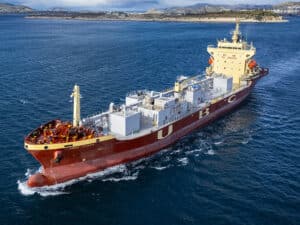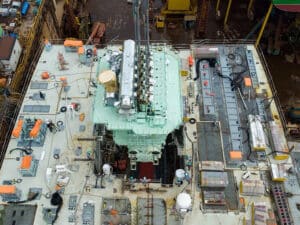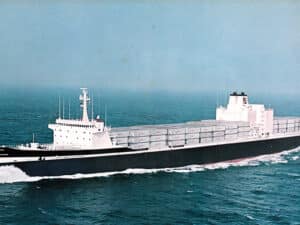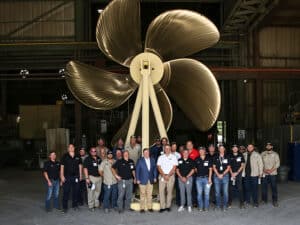
USACE targets end-of-May restoration of full Port of Baltimore access
Written by Nick Blenkey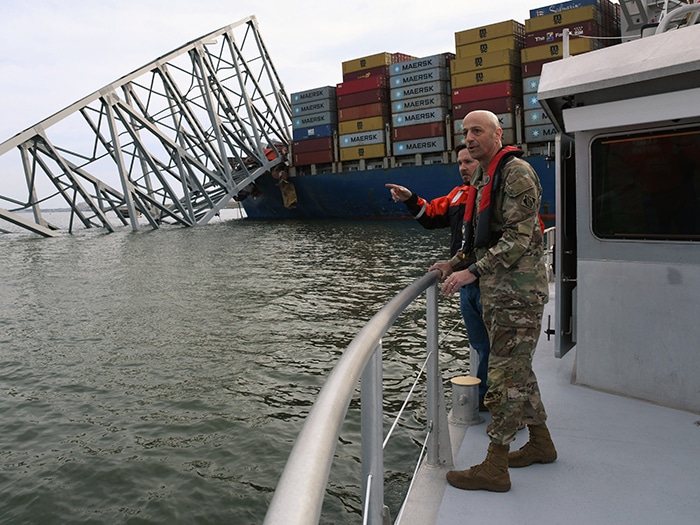
USACE Chief of Engineers Lt. Gen. Scott Spellmon views damage to the fallen Francis Scott Key Bridge. USACE is leading the effort to clear the channel as part of the larger interagency recovery effort to restore operations at the Port of Baltimore. [USACE photo by Maj. Spencer Garrison]
As work to cope with the aftermath of the Francis Scott Key Bridge collapse continued, the U.S. Army Corps of Engineers (USACE) announced a tentative timeline for the restoration of safe navigation in and out of the Port of Baltimore.
After detailed studies and engineering assessments by local, state and federal organizations, in collaboration with industry partners, USACE expects to open a limited access channel 280 feet wide and 35 feet deep, to the Port of Baltimore within the next four weeks – by the end of April. This channel would support one-way traffic in and out of the Port of Baltimore for barge container service and some roll on/roll off vessels that move automobiles and farm equipment to and from the port.
USACE engineers are aiming to reopen the permanent, 700-foot-wide by 50-foot-deep federal navigation channel by the end of May, restoring port access to normal capacity.
“Thanks to the exhaustive work of the Unified Command during the last two weeks, including underwater surveys and detailed structural analysis of the wreckage, we’ve developed a better understanding of the immense and complex work that lies ahead,” said Lt. Gen. Scott A. Spellmon, USACE commanding general. “A fully opened federal channel remains our primary goal, and we will carry out this work with care and precision, with safety as our chief priority.”
“These are ambitious timelines that may still be impacted by significant adverse weather conditions or changes in the complexity of the wreckage,” Spellmon noted. “We are working quickly and safely to clear the channel and restore full service at this port that is so vital to the nation. At the same time, we continue to keep faith with the families of the missing and are working with our partners to help locate and recover their loved ones.”
WHITE HOUSE FACT SHEET
Ahead of a visit by President Biden to Baltimore today, the White House released a Fact Sheet detailing administration efforts in support of the response to the Key Bridge collapse.
Among the highlights:
Working safely and quickly to clear wreckage and reopen the port: Clearing the wreckage will be a complex and highly coordinated effort, as teams determine how to precisely cut the bridge’s steel trusses into movable pieces; develop plans to safely extract the cargo ship, which is weighed down by thousands of tons of wreckage; and as divers navigate murky waters with little to no visibility. The Biden Administration has taken decisive action to deploy federal resources to begin work to clear the wreckage and reopen the port as quickly and safely as possible.
Unified Command: The U.S. Coast Guard immediately deployed following the collapse to support local emergency personnel. Federal agencies are working closely with the State of Maryland to survey the wreckage in the channel and allow the Port of Baltimore to reopen as soon as humanly possible. Through the Unified Command, the U.S. Coast Guard is coordinating this effort, in collaboration with the U.S. Army Corps of Engineers (USACE), the State of Maryland, and others, leveraging a unique coordinating function the Coast Guard is trained to perform in circumstances like this. The Unified Command brings order to a response with multiple stakeholders, prioritization of tasks, integration of skills and resources as needed, and prompt access to additional Federal resources as emerging needs are identified.
Completing initial survey work: Dive teams continue to work in extremely hazardous conditions, rain, choppy cold water, and little to no visibility so that surveys can be completed in order to start removing wreckage from within the federal channel. Using these surveys, USACE is developing a plan to open a deeper draft channel to allow limited cargo traffic to start transiting to the Port which will be a key step in the recovery process. This is an extraordinarily complicated process and will be executed with the safety of all personnel as the top priority.
Deploying assets for wreckage removal: Hundreds of personnel from the USACE, Coast Guard, Navy, and the State of Maryland are supporting efforts on the ground. Highly trained salvage crews successfully cut and removed the first pieces of steel wreckage from outside the federal channel on Saturday, March 30. The Unified Command has a fleet of six heavy lift crane barges to conduct wreckage removal within the federal channel, including the Chesapeake 1000, the largest crane barge on the East Coast – which is nearly 200 feet long and can lift 1,000 tons. This will be a critical asset in clearing large wreckage from across the bow of the stranded MV Dali. Earlier this week, the Unified Command was able to open two small alternate channels for essential vessels supporting wreckage removal to better access the area, marking the first time vessels have been able to cross the harbor since the bridge collapse.
Announcing a timeline for reopening: After detailed studies and engineering assessments, the USACE announce yesterday that it tentatively expects to open a limited access channel for barge container service and some vessels that move automobiles and farm equipment by the end of April and to restore the port to normal capacity by the end of May.
Providing necessary resources to rebuild the bridge: The Port of Baltimore is essential to the regional economy and the national supply chain, and the I-695 corridor, of which the Francis Scott Key Bridge was a part, provides a vital connection for people and goods traveling along the East Coast. Over 30,000 vehicles crossed the bridge daily.
Quickly releasing emergency funds: Within hours of receiving the request, the U.S. Department of Transportation’s Federal Highway Administration (FHWA) announced the immediate availability of $60 million in “quick release” Emergency Relief funds for the Maryland Department of Transportation. These funds serve as a down payment toward initial costs, and additional Emergency Relief program funding will be made available as work continues. These “quick release” Emergency Relief funds are an initial installment to help with costs associated with wreckage removal efforts, restore essential transportation and design and reconstruction on I-695 and the bridge. FHWA is also providing technical assistance, conducting site assessments, and administering emergency contracts for the new bridge.
Covering the costs of repair: The White House says that the President has also been clear since day one about his commitment that the Federal government should cover any needed costs for reconstructing the bridge. The Biden Administration is asking Congress to authorize a 100 percent Federal cost share for rebuilding the bridge. This authorization would be consistent with past catastrophic bridge collapses, including in 2007, when Congress acted in a bipartisan manner within days of the I-35W bridge collapse in Minnesota.
Holding the responsible parties accountable: President Biden also made clear that as the Administration pursues its work to clean up wreckage, clear the channel, and rebuild the bridge, it will continue to pursue all avenues to recover costs of past, current, and future work, and ensure that any compensation for damages or insurance proceeds collected will reduce costs for the American people.
Supporting industry to mitigate supply chain disruptions. The President’s Supply Chain Disruptions Task Force has engaged extensively with state and local officials, Port of Baltimore leaders, industry, labor unions, ocean carriers, rail and trucking companies, and ports along the East Coast to minimize economic disruptions. As a result of these discussions and collective efforts, import and export disruptions have been minimized. This work has included:
- Supporting the continued movement of autos and farm machinery through Baltimore. Over the past week, DOT has been working closely with the Port of Baltimore, Baltimore County, and the private Tradepoint Atlantic terminal operator to facilitate handling of additional “roll-on/roll-off” cargo at Sparrows Point, the only portion of the Port of Baltimore that is still accessible and operational following the bridge collapse. Additionally, to expand operations during this time, DOT is amending a previously awarded $8.26-million grant to help Tradepoint Atlantic take on permanent additional capacity that will also assist in handling vessels that are unable to access the other terminals at the Port of Baltimore. This funding will be reallocated to support paving of at least 10 acres, which will allow the terminal to more than double its prior capacity of 10,000 autos per month to be able to handle over 20,000 autos per month. Tradepoint Atlantic estimates the new facility will be operational later this month.
- Encouraging East Coast port coordination and streamlining of rail service to Baltimore: Because of close coordination and collaboration among East Coast ports, ocean carriers, and others, dozens of vessels unable to dock at Baltimore have been successfully diverted to other East Coast ports for unloading. To help get that cargo to Baltimore for processing and storage as seamlessly as possible, the Supply Chain Disruptions Task Force worked with Norfolk Southern Railway Company to launch a dedicated new service between Elizabeth Marine Terminal at the Port of New York and New Jersey and the Seagirt Marine Terminal in Baltimore. This service is in addition to the service that rail company CSX has announced between New York and Baltimore.
- More in the full Fact Sheet

